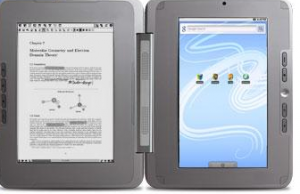 This machine seems to be a combination of e-ink reader on one side and a Wi-Fi enabled browser on the other. According to their website the e-reader screen is 1200 x 825 pixels, or 9.7 inches measured diagonally.. You can open a journal page, enter drawings with the stylus or text — either by hand or using the virtual keyboard. Then it lets you save your notes and journals to the eDGe, to a server, or email them. It can read both ePub files and PDFs.
This machine seems to be a combination of e-ink reader on one side and a Wi-Fi enabled browser on the other. According to their website the e-reader screen is 1200 x 825 pixels, or 9.7 inches measured diagonally.. You can open a journal page, enter drawings with the stylus or text — either by hand or using the virtual keyboard. Then it lets you save your notes and journals to the eDGe, to a server, or email them. It can read both ePub files and PDFs.
Here’s what they say about the other side of the unit: The enTourage eDGe™ color touchscreen is a whole netbook, ready to play movies or MP3s, organize your books, notes, and pictures, or let you instant message your friends. The screen is 1024 x 600 pixels, or 10.1 inches measured diagonally. You can view images from the e-book you’re reading on the color display. You can open a virtual keyboard and type instant messages or emails. The netbook includes an audio recorder to capture lectures for later playback or sharing. It also has a video camera to record still images or movies as MP4s or 3GP files. You can plug in headphones or a microphone or use the built in speaker and recorder.The netbook functionality comes with web browsing, audio/video record and playback, an email function and contacts list, a calculator, an alarm clock, and a library function to manage your books and files. The enTourage eDGe™ uses the Google® Android® operating system, so you can add other applications you need. The enTourage eDGe™ has built in WiFi®, plus optional 3G capability using an EVDO or HSDPA mobile modem. You can quickly download e-books, send an email, browse the web, or combine your notetaking, emailing, and browsing, all from one device. The eDGe also includes BlueTooth® capability to add an external keyboard.
It looks a bit like a solution in search of a problem, at least to me, especially at the $490 asking price, but Android fans might be interested. Thanks to Bennett Z. Kobb for the heads-up.






























Let’s hope this double-screen device rush hastens the arrival of Pixel-Qi truly hybrid-screen, multipurpose devices, or others like Qualcomm Mirasol screen devices …
Wowsers on that photo! I like this and yet worry about even more mtasking, aka multitasking!!! But cool and very interesting. Reminds me too of the new dual screen computer being made by an Alaskan firm. Have you seen those photos yet. It’s a normal keyboard but the computer has two screens, i have no idea why. But looks cool.
Looks heavy, awkward and prone to expensive breakage.
For me, half the joy of an ereader is that you can hold it in one hand and read anywhere since it is smaller and lighter than a pocketbook.
related news item: Taiwan’s Asus to make double-screen e-reader to challenge the Kindle
Eric Engleman reports:
http://www.techflash.com/seattle/2009/09/netbook_maker_asus_to_launch_electronic_reader.html?ana=from_rss
The list of competitors lining up to challenge Amazon’s Kindle is growing almost daily. The latest is Taiwan-based netbook maker Asus, which plans to launch an electronic reader by year’s end.
The new device will have two screens and a hinged spine — giving it a book-like appearance and in theory letting people read from one page to the next. WOW! That is a revolutionary design! Cool!
PHOTO OF DOUBLE SCREEN ASUS DEVICE HERE:
http://zippy1300.blogspot.com/search?q=double-screen
What’s interesting to me is that these double screen designs we’re seeing of late (Asus, eDGe, MS Courier) show a very clear focus on the educational market. Which is an emerging sign of maturity in the nascent ebook industry as it signals a shift from generic technology “you can read an ebook!” to application/customer-focused designs “one screen for reading and one for anotations!”. Just displaying ebooks is not enough for a proper educational device; annotation and notetaking, data-management and formatting also need to be factored-in. Basically, where recreational readers are a pure content *consumption* device, educational readers need to add content *creation* features.
I may be a recreational reader myself but I’m not blind to the reality that the textbook market is going to be way bigger and way more profitable to all players than recreational reading.
The only question I have is why has it taken this long to get started.
To me, the logical starting point for educational ebook readers is *not* eink slates, but rather netbooks and UMPCs. The Asus dual pane reader may very well represent the direction the industry moves in, maybe with generic LCD screens (they *are* cheap), maybe with color eink, maybe with PixelQi screens, maybe something else. Ultimately, though, the true victor in this coming war will be the one with the best *software* not the best screen.
Going to take a while…
I’m still wondering how come libraries have spent millions over the last decade or so to build digital collections and failed at empowering the user to socialize the contents of such collections. It’s been quite a matter of building awesome collections, improving visibility and access, and overlooking interaction with text and other users. Much like a monumental site rather than an environment to live in.
You say: “It looks a bit like a solution in search of a problem”. Well, the problem is the need to carry too much ‘stuff’. Personally, I carry both an e-book (Kindle 1) and an internet capable phone (Omnia). I love the e-reader .. nuff said. To have an e-ink e-reader AND LCD web browser, each with a ~10″ screen seems like a real problem solver to me. As for the price, this size screen on a Kindle – the DX (with no LCD web browser) goes for the same dollar amount. If the eDGe e-reader gets linked with a good book source and allows for instant book downloads, I’ll cough up $490 in a minute.
P.S. If ATT had decent cell phone coverage in my part of town I’d own an iPhone and probably wouldn’t be writing this. Then again, screen size is definitely a consideration.
One last point .. If size becomes an issue, Spring Design’s ALEX looks like a pretty good compromise solution (6″ e-ink screen, 3 1/2″ LCD browser with the capability of transferring browsed topics to the larger e-ink screen).
videos :
1) Ebook : http://www.youtube.com/watch?v=Kny34GJx8mg
2) Iphone : http://www.youtube.com/watch?v=awGR7YDe45Q